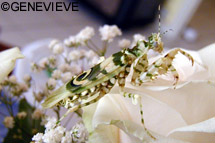Mantids should be raised in individual
terrariums because they are generally cannibals. There
are a few exceptions (such as Phyllocrania nymphs and
Gongylus) to this general rule.
For breeding, if you lack a terrarium, you
can use a bottle cut in 2 and closed with a piece of
netting or screen. The volume of the bottle will depend
on the age and size of the mantis. For the bigger
varieties sorts as Sphrodomantis, a terrarium of 15x15x20
is useful (common 10 gallon aquariums are excellent). The
height is crucial for allowing the mantids to molt.
At mating time, a terrarium is needed to
provide a more spacious environment in which the male can
court comfortably… and make a hasty escape if
necessary. Despite hearsay, male mantids are not always
eaten; in fact, if the female is well-fed, he’s
usually in no danger whatsoever.
For heating and humidity it is necessary to
refer to your insect’s country of origin.
Temperatures of 20 - 26°C (68 - 78°F) are an
acceptable range. As for humidity, you can lightly mist
the terrarium daily with a spray-bottle. The mantid will
drink by absorbing droplets. 70% humidity seems
satisfactory on average.
Also needed are branches of foliage of some
sort (plastic or alive) that are 2 to 3 times the size of
your insect to allow proper metamorphosis. If
there’s insufficient room to molt it will not be
able to extricate itself from its former skin, which
might prove fatal - at best, it could emerge somewhat
misshapen or minus one leg…
Mantids eat live prey: fruit-flies and
greenflies for the youngest, then house-flies, crickets,
roaches, mealworms, etc....
In warmer seasons, you can use a bug net to
collect the "plankton of fields" - mantids will eat just
about any bug it can capture, and will appreciate the
variety and freshness of your outdoor meals! The only
critters not recommended for mantid consumption are
larger/more aggressive spiders and insects, and
snails/slugs.
For mating, you really only need to make
sure of two things: that you have a male/female pair in
the first place, and that the female is extremely
well-fed.
To differentiate (sex) them, it is rather
easy: the male is slim and often possesses bigger
antennae. The female is more round and typically
significantly bigger. Furthermore, the male possesses 8
segments on the bottom of the belly, the just female
6.
After the male approaches and jumps on the
back of the female to fertilize her, it will likely be
necessary to remove him (always remove the male after 2
days, mated or not). You can then put him down in another
female’s terrarium to mate again or back in his own.
When handling, please be sure not to pinch or squeeze
him; instead, gently hold both the male and female by the
thorax to provide an impetus for them to separate.
The female lays an ootheca (egg case) in
the terrarium, usually on a branch or in a corner.
Oothecas can contain up to 300 babies, depending on
species, who will emerge at the end of 3 to 6 months.
Most female mantids lay more than one ootheca but these
will contain fewer and fewer eggs as they are laid.
After their birth, the babies (nymphs) are
identical to the parents but without wings: some species
do not even have wings at all in any point of their
life-cycle.
To maintain the new nymphs, you have a
couple options:
· You can separate them individually
in small bowls (such as see-thru deli cups, yogurt cups,
etc.)
· You can leave them together through
the first few stages so that the weakest are killed
naturally by cannibalization. As harsh as it sounds, this
is a good way to ensure that inferior specimens are
‘weeded out’. There is a second advantage to
this technique as well: you can put a fruit-fly culture
directly in with them to make feeding all those nymphs
easier.
Certain species are extremely sensitive to
inbreeding and require you to find parents outside your
breeding group to provide a fresh influx of genes. If not
fulfilled, the ootheca will be increasingly sterile. In
the long run, this will result in deformity and more
fragile animals.
If you would like to begin breeding
mantids, we particularly recommend Sphrodomantis. They
are large, hardy, and reproduce well.
We wish you good luck breeding!!! ;o)





























































































